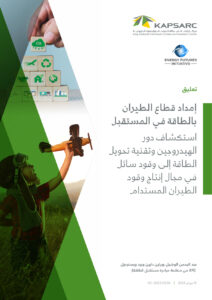
إمداد قطاع الطيران بالطاقة في المستقبل استكشاف دور الهيدروجين وتقنية تحويل الطاقة إلى وقود سائل في مجال إنتاج وقود الطيران المستدام
تنطوي جهود الحد من الانبعاثات الكربونية لرحلات النقل طويل المسافات على تحديات جسيمة لا سيما في قطاع الطيران. فبينما أمكن إحراز تقدم في الحد من انبعاثات وسائل النقل الحضرية، فإن التحول إلى استخدام الكهرباء في وسائل النقل طويل المسافات ما زال أمرًا عسيرًا. وفي هذا الصدد، تقدم لنا أنواع وقود الطيران المستدام (SAFs) حلًّا واعدًا لتقليل انبعاثات ثاني أكسيد الكربون الناتجة عن قطاع الطيران. وأنواع الوقود المستدام هذه -التي يمكن استخلاصها من مواد عضوية أو تصنيعها من ثاني أكسيد الكربون والهيدروجين- لديها القدرة على تقليل انبعاثات ثاني أكسيد الكربون بنسبة 80٪ (Airbus 2023). ويهدف قطاع الطيران إلى إنتاج ما يكفي من تلك الأنواع من الوقود لتلبية الطلب على وقود الطيران بحلول عام 2050، وذلك عبر طرق منها تقنية تحويل الطاقة إلى وقود سائل (PtL)، التي تبيَّن أنها يمكن أن تكون نهجًا بديلًا لإنتاج وقود الطيران المستدام. وتقدم هذه الورقة البحثية بعض الرؤى عن تطبيق واستخدام هذه التقنية. في الظروف المثالية، تتضمن عملية تحويل الطاقة إلى وقود سائل استخدام الطاقة الكهربائية المتجددة، والهيدروجين المنتَج من مصادر الطاقة المتجددة، والكربون المستخلَص، وذلك لإنتاج أنواع الوقود الاصطناعية. وتختلف تقديرات كمية الهيدروجين المطلوبة في عمليات إنتاج وقود الطيران المستدام بتلك التقنية من سيناريو إلى آخر، إذ سوف تتراوح بين 94.3 مليون و224.5 مليون طن متري بحلول عام 2050. فالهيدروجين سيكون له دور حاسم في تمكيننا من إنتاج وقود الطيران المستدام على نطاقٍ واسع، وتحقيق أهداف الحد من الانبعاثات الكربونية في قطاع الطيران. ولهذا لا بد من الاستمرار في ضخا لاستثمارات في الطاقة المتجددة (RE) وتطوير التقنيات، وذلك لاستغلال كامل إمكانات الهيدروجين وتقنية تحويل الطاقة إلى وقود سائل في إنتاج وقود الطيران المستدام.
30th نوفمبر 2023